Understanding Plucked Parrots: Causes and Solutions
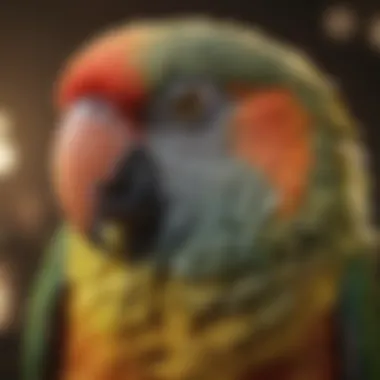
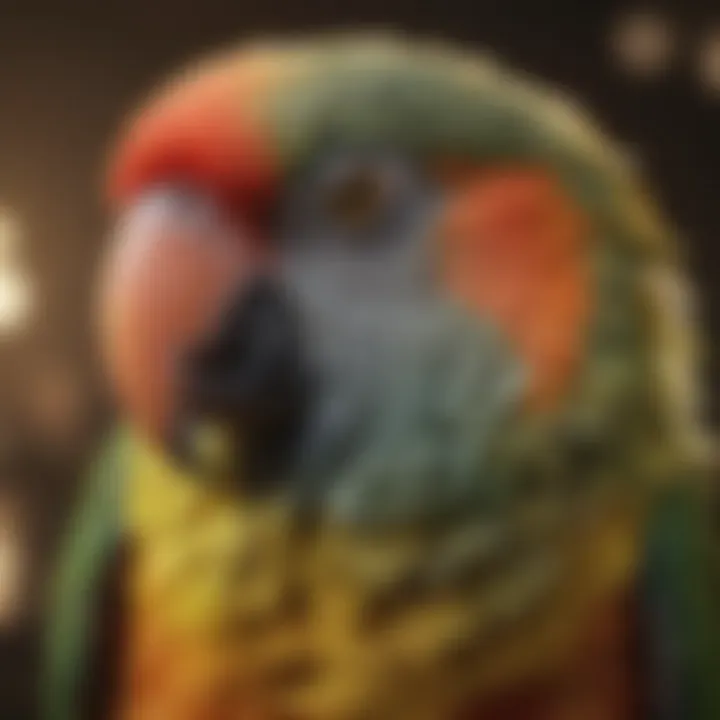
Intro
Feather plucking in parrots, a visible sign of distress, is a major concern for bird owners. Understanding this complex behavior is essential for providing the best care for these intelligent creatures. Many factors can contribute to feather plucking, including environmental, emotional, and health-related issues. Recognizing these will help caregivers address the root cause and prevent further complications.
Care Tips
Providing a safe and loving environment is one of the most crucial aspects of caring for your parrot. Below are ways to enhance daily care routines and maintain a healthy habitat for your bird.
Daily Care Routines
Establishing a consistent daily routine may enrich your parrot's quality of life.
- Morning Interaction: Spend time with your bird each morning. Initiating conversation or simple interaction helps to build trust.
- Feeding: Offer a varied diet to ensure nutritional needs are met.
- Monitoring Exercise: Allow time outside the cage for adequate exercise.
Cage Setup and Maintenance
The bird's cage should provide comfort lost over time due to feather plucking. Positioning and cleanliness matter.
- Location: Place the cage in a vibrant area of the house.
- Size: Make sure the cage is spacious enough to allow flying.
- Maintenance: Regular cleaning ensures hygiene and prevents illnesses.
Hygiene and Cleaning Practices
Preventative health is vital.
- Regular Nesting: Clean perches and toys weekly to ward off germs.
- Bathe the Bird: Shower your parrot every few days for feather and skin care.
Seasonal Care Adjustments
During different seasons, environmental factors may stress parrots. Adapt their care accordingly.
- Winter: Keep the cage away from drafts to prevent illness.
- Summer: Ensure proper hydration and a cool setup during heat waves.
Behavioral Insights
Understanding and addressing behavioral issues is key to managing feather plucking.
Understanding Bird Body Language
Birds' behavior often speaks volumes about their feelings. Look for signs such as:
- Posture Change: A tucked head can mean they feel insecure.
- Harsh Calls: Repeated loud sounds may show fear or discomfort.
Common Behavioral Issues and Solutions
Feather plucking can stem from several behavioral issues.
- Boredom: Persistent plucking may indicate the need for stimulation.
- Stress: Try reducing stress factors, like loud noises or sudden changes.
Positive Reinforcement Techniques
When trying to correct behavior, consider reward systems.
- Treats for Good Behavior: Encourage desired actions by giving small rewards.
- Verbal Praise: Encourage trust with positive reinforcement.
Social Interaction Needs
Parrots are naturally social animals. Establish effective channels for soft interaction, both with humans and other birds.
- Time Together: Schedule interactive sessions regularly.
- Dual Birds: Many owners find success when providing a companion.
Nutrition Guides
Balanced nutrition prevents health problems that might lead to feather plucking.
Essential Diet Components
Healthy diets consist of:
- Fruits and Vegetables: Aim for fresh! Citrus fruits and leafy greens are great options.
- Seeds and Pellets: Ensure high-quality commercial pellets for the main diet.
Safe and Toxic Foods
Educate yourself on what is safe for your parrot.
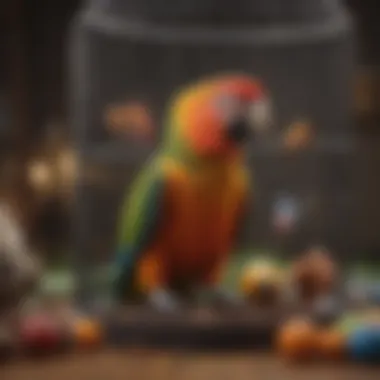
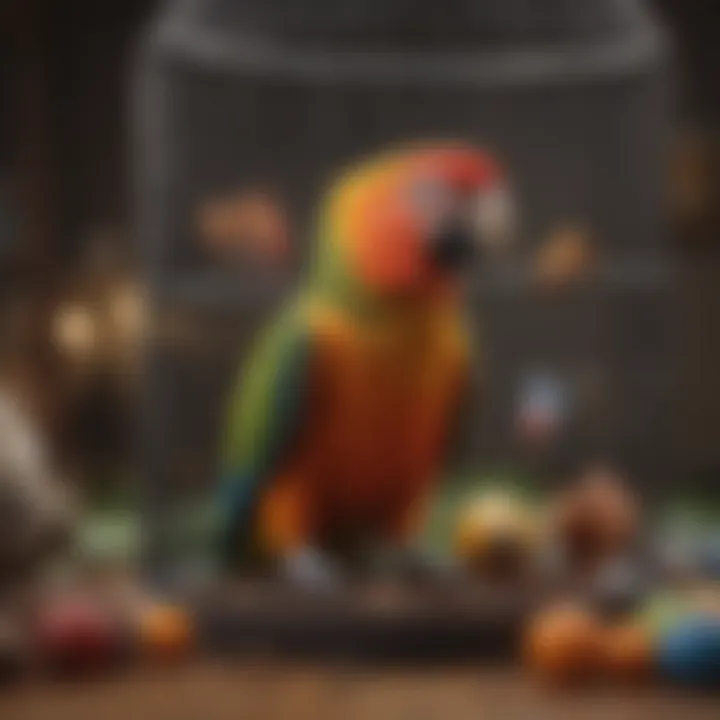
Safe Options:
- Apples and berries
- Carrots and broccoli
Toxic Choices:
- Avocados
- Chocolate and caffeine
Supplements and Treats
Supplements can sometimes benefit a bird's wellbeing:
- Consult your vet on using vitamins or minerals if needed.
- Offer seeds or dried fruits as motivational treats.
Feeding Strategies for Different Species
Different species may require tailored feeding tactics.
- Smaller Birds: Need less food but frequent options.
- Larger Birds: Require more solid meals with ample produce.
Wellness and Health
A holistic approach to health helps prevent issues like feather plucking.
Routine Health Checkups
Scheduled vet visits are necessary to monitor health.
- At least once a year, schedule a complete check-up.
Identifying Symptoms of Illness
Watch for these red flags:
- Changes in eating and drinking patterns.
- Feather loss or skin problems.
Preventative Care and Vaccinations
Discover vaccination needs and establish care plans with your veterinarian.
Mental and Emotional Well-being
Consider your parrot's emotional state. Boredom or neglect can lead to change in behavior. Make efforts to ensure an engaging environment.
Enriching Activities
To foster a fulfilling life for your parrot, create enriching activities.
Toys and Playtime Ideas
Invest in diverse bird toys for interaction. Safe options might include:
- Wooden toys
- Chewable ropes
Training and Tricks
Provide stimulation through basic training:
- Use simple commands like
Preface
Feather plucking in parrots is a significant topic among avian enthusiasts. This behavioral issue deeply impacts both the emotional and physical well-being of these vibrant creatures. A sound understanding of this problem is vital for bird owners as they seek to provide the best care for their pets. The emergence of feather plucking can indicate a range of underlying causes. Addressing this behavior is essential not just for the health of the bird but also for long-term companionship satisfaction.
The Emergence of Feather Plucking
Feather plucking is not a new phenomenon. It has gained considerable attention in recent years as more bird owners encounter parrots engaging in this self-destructive behavior. Various studies and observations indicate several potential causes, each intertwining psychological, environmental, and medical elements. When a parrot plucks its feathers, it often reflects a deeper set of issues requiring urgent attention.
Multiple factors may initiate feather plucking. It could result from boredom, stress, or anxiety due to unfavorable living conditions. Additionally, when birds undergo a traumatic event or experience a major change, such as a new home or routine, they may start to pluck. Recognizing the triggers is crucial for mitigation and recovery efforts.
Importance of Understanding Parrot Behavior
Having a deep understanding of parrot behavior is fundamental for both new and experienced bird owners. Parrots are complex creatures and their mental state manifests visibly in their actions. Keen observance and comprehension of such nuances empower owners to acknowledge issues before they escalate into serious problems, such as feather plucking.
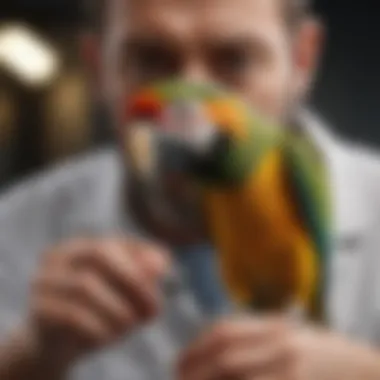
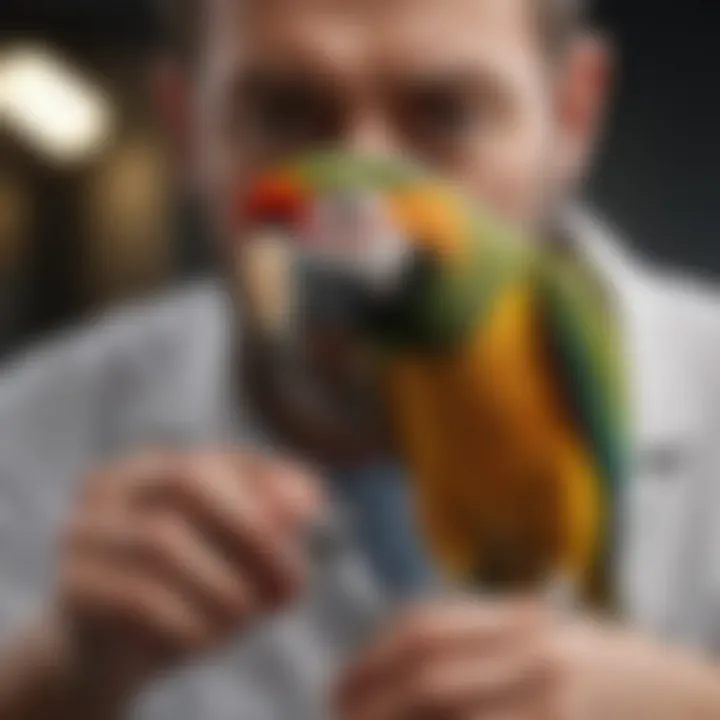
A well-informed owner can better comprehend signals their bird is sending. Knowledge enables proactive measures and adaptations that facilitate extraordinary care for any parrot. This not only elevates the quality of life for the bird but also strengthens the bond between pet and owner. Furthermore, by understanding natural parrot behavior, owners can identify signs that actual mating or seasonal molting might be misinterpreted as problematic actions.
Regular assessments and interventions based on informed observations lead to improvements, while preventing negative behaviors from taking hold. The opportunity to transform is dictated significantly by an owner's steadfast commitment to increasing their knowledge about these captivating animals.
Contextualizing Feather Plucking
Feather plucking in parrots is a significant issue that touches upon various aspects of avian well-being. Understanding this phenomenon is crucial for improving the quality of life of these birds. Highlighting its causes and effects provides valuable insights for pet bird owners, aspiring bird parents, and breeders alike. This section aims to properly set the stage for the detailed discussions that follow, effectively synthesizing essential elements of this pressing concern.
Defining Feather Plucking
Feather plucking refers to an involuntary behavior where parrots remove or pull out their feathers. This behavior may extend to the skin in extreme cases, leading to severe damage and distress. In medical terms, it is classified as a type of
Common Causes of Feather Plucking
Understanding the causes of feather plucking is crucial for bird owners. Recognizing what triggers this behavior can prevent harsh consequences for their pets. Each identified cause helps refine the approach to care and environmental setup that fosters a healthier, less stressful living situation for parrots. Moreover, addressing these factors early may reduce potential physical and behavioral harm for affected birds.
Psychological Factors
Parrots are intelligent creatures with complex emotional lives. Stress and boredom can lead to feather plucking. Some birds experience anxiety from separation from human companions or a lack of mental stimulation.
Avian veterinarians often emphasize the need for mental engagement to combat psychological stress. Toys, puzzles, and social interaction can be vital in mitigating these issues. When a parrot feels anxious or neglected, it might begin to pluck its feathers as a coping mechanism. This behavior becomes habitual without interventions. Observation plays an essential role; owners should watch for signs of gears in behavior that indicate frustration or anxiety.
Environmental Stressors
The environment a parrot is kept in significantly impacts its behavior. Factors like loud noises, sudden changes, or unstable housing arrangements can lead to stress. Cages that are too small or lack proper enrichment can exacerbate feather plucking tendencies. Furthermore, exposure to drafts, sudden changes in temperature, or the presence of potential predators in the home can add additional layers of discomfort for a parrot.
Creating a stable habitat that includes appropriate space and safety features will help the bird feel secure. Owners must ensure their birds feel part of the household, maintaining a calm and loving environment.
Medical Issues
Underlying medical conditions often contribute to feather plucking behaviors. Skin infections, allergies, or hormonal imbalances can cause irritation and discomfort. Parrots might pluck feathers as a direct response to physical ailments. /nearly every, ongoing discomfort could be reason for moment to pull away its feathers.
It’s vital for owners to seek proper veterinary care to identify any health issues if plucking becomes apparent. Regular check-ups can establish a baseline of health and allow veterinarians to spot any worrying changes. This thoroughness fosters positive outcomes, preventing the progression of plucking behavior due to unseen physical problems.
The Impacts of Feather Plucking
Feather plucking in parrots often goes beyond mere aesthetics. It signifies deeper emotional and physical struggles for these avian companions. Understanding the impacts of this behavior is crucial for effective intervention. Recognizing how feather loss affects a parrot can lead to timely actions that aid in the recovery of the bird's well-being.
Physical Consequences
The first area to consider within the impacts of feather plucking is the physical health of the bird. When parrots remove their feathers, they expose their skin to the environment. This can lead to several issues, including:
- Skin Infections: The absence of feathers allows bacteria and parasites easier access to the skin. This increases the risk of skin infections, which can become serious if not treated.
- Heat Regulation Difficulties: Parrots rely on feathers for insulation. With plucking, a bird can struggle to maintain its body temperature, potentially leading to hypothermia in cold conditions.
- Wounded Skin: Continuous plucking can result in open wounds. These wounds not only cause discomfort but also significantly impair the bird's quality of life.
Overall, it is essential for parrot owners to be aware of the potential for these physical complications resulting from feather plucking.
Behavioral Changes and Distress
Plucking is also deeply rooted in behavioral health, as it can lead to significant changes in temperament and observable distress in parrots. In many cases, feather plucking arises as a response to stress or emotional difficulties. Common behavioral challenges include:
- Increased Aggression: Birds may exhibit aggressive behavior towards their owners or other pets due to frustration or unease.
- Social Withdrawal: Parrots can become quite withdrawn, displaying a lack of interest in interaction, which may aggravate their psychological state.
- Compulsive Behaviors: In severe cases, plucking may become a compulsive behavior that is difficult to interrupt. This can lead to a cyclic pattern of distress and further feather loss.
Research has shown that awareness and proactive monitoring can lead to better outcomes for affected parrots. Addressing feather plucking requires a comprehensive understanding of all its physical and behavioral impacts. Both aspects are interconnected, revealing the significant toll this behavior takes on a parrot's overall health. By prioritizing this understanding, caregivers can implement effective strategies for prevention and treatment of feather plucking.
Parrot owners should not underestimate the importance of addressing behavioral issues as they can have lasting impacts on feather health.
Assessing the Severity of Plucking in Parrots
Determining the severity of feather plucking in parrots is a crucial aspect of understanding this behavior. An effective assessment aids bird owners in tailoring positively their response and treatments. It reflects the current state of the parrot's health, both physical and mental. Identifying the degree to which feather loss has occurred can guide interventions and set expectations for recovery. Immediate understanding enables timely actions that significantly affect outcomes for the parrot.
Observation and Documentation
Observing and documenting a parrot's feather plucking behavior is essential for effective management. Short sessions of attentive monitoring can reveal patterns that explain when and how seeking verification occurs. This allows the owner to categorize the likeliest cause. Usually documenting bouts, duration, and specific areas of plucking forms a comprehensive picture. Note observable details such as:
- Times of the day when plucking is most frequent.
- Any correlating events leading to an episode.
- Environmental factors notably changes, like rearranged furniture, noise increases, or exposure to unfamiliar people or pets.
Erroneous assumptions can happen if these factors are overlooked. Meticulous records also provide insights that can aid in discussion with veterinarians and behaviorists, ensuring they are fully informed.
Veterinarian Evaluation
A veterinarian evaluation plays an integral role in assessing feather plucking severity in parrots. A comprehensive veterinary examination can help distinguish behavioral plucking from issues stemming inherently from physical conditions. During the visit, perform the following:
- Conducta thorough physical exam, looking for skin irritation or underlying infections that may cause discomfort and lead to plucking.
- Discuss frequency, intensity, and any relevant behavioral observations documented earlier, relating them to potential medical issues.
- Suggest diagnostic tests if required. These may include blood tests to evaluate organ function and illnesses that could lead to stress and feather loss.
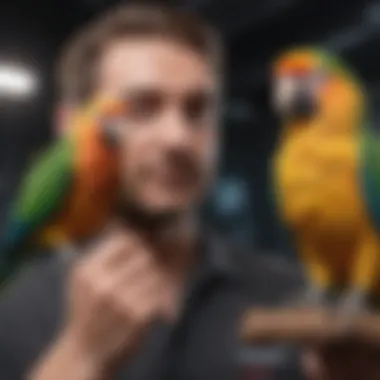
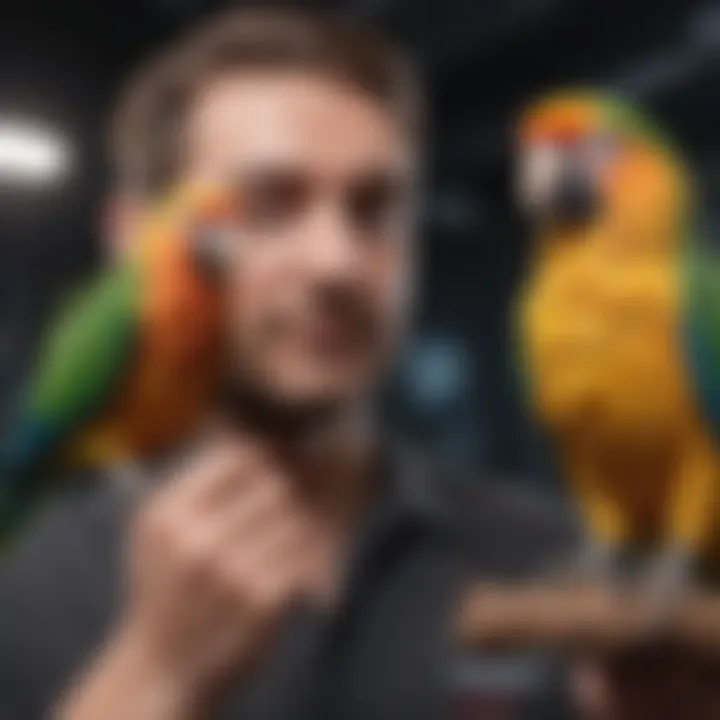
Veterinary evaluation assures bird owners that no undisclosed medical problem exists and provides pertinent medical recommendations for moves forward regarding addressing feather plucking. Following these protocols will enhance overall well-being and ensure progress in treatment plans. As noted previously, a dedicated veterinarian supports dedicated pet owners in holistic treatment plans for tackling feather plucking issues.
Strategies for Prevention and Correction
Feather plucking in parrots is a complex behavior that demands a thoughtful approach to both prevention and correction. By implementing strategic measures, owners can effectively reduce the likelihood of this troubling issue. The importance of addressing feather plucking cannot be overlooked, as it impacts the emotional and physical health of these vibrant birds. Every step taken towards suitable prevention and correction not only benefits the parrot but also enriches the relationship between bird and owner.
Creating a Stimulating Environment
A stimulating environment is pivotal for the well-being of parrots. Birds are naturally curious and highly intelligent, necessitating an engaging space that fulfills their physical and cognitive needs. Here are a few ways to create an enriching habitat:
- Diverse Toys: Providing various types of toys is crucial. Rotate them frequently to maintain interest from the bird. Consider puzzle toys that encourage problem-solving, or toys that can be chewed for physical engagement.
- Perches and Spaces: Utilize different types of perches. Birds can benefit from varying heights, textures, and diameter. Additionally, ensure they have safe and secure spaces for hiding or resting, helping them feel secure.
- Social Interaction: Encourage positive interaction between the parrot and family members. Regular, engaging conversations can foster better bonds and reduce loneliness. Consider setting designated times for direct socialization on their terms.
- Natural Elements: Where possible, include branches or elements from the natural environment. This helps convince the bird it is living in a more natural habitat, which can be comforting.
Behavioral Modification Techniques
Behavioral modification is essential when attempting to correct feather plucking. Adjustments in how homeowners interact with their birds can yield notable changes. Consider these techniques:
- Positive Reinforcement: Rewarding desired behaviors with treats or affection often encourages repeat occurrences. Immediately acknowledging non-plucking behaviors can instill motivation for the bird to refrain from destructive habits.
- Redirecting Behavior: One effective method involves redirecting a parrot's plucking tendencies towards more appropriate activities. If a bird is pecking at its feathers, simply shifting its attention to a toy or alternative activity can help.
- Consistent Routines: Establishing a daily schedule promotes stability. Birds thrive on routine, and knowing what to expect reduces stressors that may contribute to feather plucking.
- Monitoring Behavior: Keeping a daily log of when the plucking occurs can significantly aid in identifying potential triggers. Noting times and situations can direct focus towards specific behavioral interventions.
Veterinary Interventions
In some cases, professional assistance from a veterinarian may be required, especially when behavioral strategies don't lead to change. Here are key considerations:
- Medical Evaluation: Parrots may pluck due to underlying health issues such as allergies, skin infections, or hormonal imbalances. Veterinary intervention can determine if there's a medical factor at play. An annual check-up with an avian vet can detect ailments before they escalate.
- Nutritional Consultation: Diet plays a vital role in feather health. An avian vet can recommend necessary dietary adjustments to ensure all nutrients are included. A well-balanced diet helps maintain health and reduces stress-related behaviors.
- Pharmaceuticals: In severe cases, medication may be necessary. This could involve supplements to calm anxiety or other prescribed treatments that support behavioral change.
Engaging with professionals is a key part of the recovery process for plucked parrots. Their expertise can provide tailored approaches to both prevent further plucking and foster healing for the affected parrot.
Long-term Management Strategies
Long-term management strategies play a crucial role in ensuring the ongoing well-being of plucked parrots. Effective management goes beyond immediate solutions, focusing on sustainable practices that foster a stable environment emotionally and physically for your bird. Proper management aids in reducing stressors that lead to plucking, and encourages positive behaviors that promote a healthier mindset for the pet.
The significance of regularly reviewing these strategies cannot be overstated. Consistent adjustments can lead to better adherence to preventive measures, hence making it easier for owners to maintain an atmosphere in which feather plucking is less likely to occur. This section outlines critical elements for long-term care with comprehensive comparisons on addressing various Padditional aspects you may encounter.
Follow-up Care and Monitoring
Follow-up care and monitoring are integral components of the long-term management strategy for plucked parrots. When managing a continuous condition like feather plucking, a routine system of care ensures both bird and owner have comprehensive understanding regarding the pet’s mental and physical states.
Regular observations show if any adjustments are necessary in an emergent strategy. Noticing recurring behavior regarding feather plucking helps to assess effectiveness of previous strategies and identify new triggers or stressors.
It’s beneficial to keep a journal of the parrot’s physical appearance and behavior between vet visits. Note any changes on a daily or weekly basis as climatic adjustments, alterations in diet or changes in caretakers can all introduce variables that cause stress in birds.
By documenting your parrot's behavior and objectively determining reactions to new environments, owners build a foundation of effective interventions.
Consultation with Avian Behavioral Specialists
Consultation with avian behavioral specialists provides valuable insights for owners dedicated to their parrot's well-being. These professionals analyze issues related to plucking in a specialized manner. Creating a detailed history of your bird's behavior patterns assists specialists in delivering endorsing solutions that may not arise during routine veterinary visits.
Specialists utilize different behavioral approaches based on their knowledge and experience. Suggestions may include various therapy adjustments, enhancing training regimes, or incorporating environmental changes that positively influence well-being. Specialist support often facilitates media functional methods for communication. Thus, improving the interactive experience between the bird and its owner.
In summary, maintaining ongoing communication and employing specialist insights enforce tangible results in an avian care routine. Every unhealthy behavior comes with change, hence modifying the living conditions might buffer against triggers to feather plucking.
End
Summarizing the Importance of Awareness
Understanding the issue of feather plucking in parrots is vital for any bird owner. Awareness allows owners to recognize signs early, which can significantly impact intervention effectiveness. An informed owner is more likely to notice gradual changes in behavior or plumage. They can also better comprehend the multifaceted nature of plucking—be it psychological, environmental, or medical. There is often a myth that feather plucking is merely a behavioral issue related to boredom or attention-seeking; however, the various underlying factors highlight the importance of taking this behavior seriously. Ignoring it can lead to compounded distress for both the bird and the owner.
Through persistent research and acknowledgment of bird behavior, owners can foster a supportive environment conducive to healthy feather development. A deeper understanding also ensures compassion toward the flock members who struggle with feather plucking.
Encouragement for Ongoing Education
Education must not stop with understanding the causes and effects of feather plucking. For parrot owners, continuous learning is essential, extending beyond initial information gathered during research. Engaging with resources like avian behavioral courses, specialized forums such as reddit.com, and communication with avian veterinarians can keep knowledge up to date. Resources specific to feather plucking should be explored, giving insights into effective preventative measures and corrective strategies.
Networking with fellow bird enthusiasts or attending workshops can illuminate practical tips not found in literature. Bird owners face new challenges and methods emerge; thus, ongoing education plays a crucial role. Updating one’s knowledge can help develop lasting strategies for pser non-plucking behaviors, ensuring both the pet and owner have harmonious lives together.
Educating oneself on the issues surrounding feather plucking can lead to success in preventing and correcting this behavior. Every bit of knowledge paves the path to healthier environments for parrots.
Recommended Reading
Diving into literature related to avian care deepens comprehension of problematic behaviors. Here is a selection of valuable books and articles for familial readers:
- The Parrot Problem Solver by Barbara Heidenreich
- Pluck the Feather: A Guide to Parrot Plucking by Dr. Irene Pepperberg
- Articles on websites like en.wikipedia.org and britannica.com can provide scientific perspectives regarding bird health and psychology.
Such reading often offers a mix of anecdotal evidence and research, giving owners frameworks to understand and address their parrots' needs.
Professional Training and Workshops
Accessing professional workshops offers an excellent chance to learn practical behavior modification techniques. Industry experts typically provide tailored knowledge for dealing with specific plucking issues.
- Organizations like the American Association of Avian Veterinarians (AAAV) often host workshops that provide insight into common behavioral issues.
- Online courses may position interested bird owners alongside pros in avian behavior, effectively assisting owners in the application of new techniques as they care for their parrots.
- Community-driven training can also deliver relevant advice. Learning from experienced parrot owners on forums like reddit.com allows for exchanging actionable tidbits on managing plucked feather behavior.
Exploring training programs and workshops is often a wise investment. They equip owners with informed methods to enhance the experience of both themselves and their parrots.















